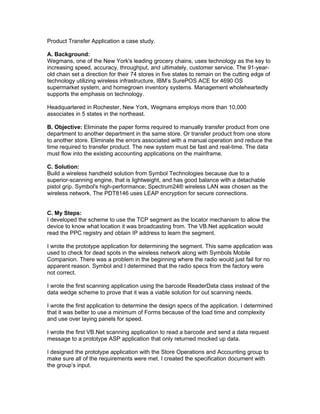Product Transfer a Case Study
- 1. Product Transfer Application a case study. A. Background: Wegmans, one of the New York's leading grocery chains, uses technology as the key to increasing speed, accuracy, throughput, and ultimately, customer service. The 91-year- old chain set a direction for their 74 stores in five states to remain on the cutting edge of technology utilizing wireless infrastructure, IBM’s SurePOS ACE for 4690 OS supermarket system, and homegrown inventory systems. Management wholeheartedly supports the emphasis on technology. Headquartered in Rochester, New York, Wegmans employs more than 10,000 associates in 5 states in the northeast. B. Objective: Eliminate the paper forms required to manually transfer product from one department to another department in the same store. Or transfer product from one store to another store. Eliminate the errors associated with a manual operation and reduce the time required to transfer product. The new system must be fast and real-time. The data must flow into the existing accounting applications on the mainframe. C. Solution: Build a wireless handheld solution from Symbol Technologies because due to a superior-scanning engine, that is lightweight, and has good balance with a detachable pistol grip. Symbol's high-performance; Spectrum24® wireless LAN was chosen as the wireless network. The PDT8146 uses LEAP encryption for secure connections. C. My Steps: I developed the scheme to use the TCP segment as the locator mechanism to allow the device to know what location it was broadcasting from. The VB.Net application would read the PPC registry and obtain IP address to learn the segment. I wrote the prototype application for determining the segment. This same application was used to check for dead spots in the wireless network along with Symbols Mobile Companion. There was a problem in the beginning where the radio would just fail for no apparent reason. Symbol and I determined that the radio specs from the factory were not correct. I wrote the first scanning application using the barcode ReaderData class instead of the data wedge scheme to prove that it was a viable solution for out scanning needs. I wrote the first application to determine the design specs of the application. I determined that it was better to use a minimum of Forms because of the load time and complexity and use over laying panels for speed. I wrote the first VB.Net scanning application to read a barcode and send a data request message to a prototype ASP application that only returned mocked up data. I designed the prototype application with the Store Operations and Accounting group to make sure all of the requirements were met. I created the specification document with the group’s input.
- 2. I suggested to management to use the stores pricing file to lookup pricing. This required the handheld to read the IBM proprietary file system. I chose the Gefion LiteWebServer as my Webserver because of the small foot print to run on the in-store controller. I chose the Java servlet container for the code because IBM had support for JVM 1.1.8 and 4690OS API’s to read the files. I wrote the first test application to return test data and then real pricing data from a test controller. I modified the PTS application to include a fail-over scheme for data lookups in which the application would request data from the controller and if it didn’t respond within the timeout value a new request would be made to a backup machine this was done in a round robin fashion. If the old request did show up it would be thrown away. I had a 24/7 mandate to provide data and this code did satisfy the user requirement. The PTS specification that I had written called for transaction data to be saved in the handheld incase of a network or a machine outage. Symbol suggested a product from Odyssey Software that could do this functionality. I updated the specifications and got permission to use the product. I had the programmer install the classes and build the code into the PTS application. This allowed the application to operate if the network connection was down back at corporate. The lookups were still done locally. I decided to use Web services calls to populate the data in the handheld device using XML-RPC. This would reduce the work that he operator had to perform. The lists and textboxes were coded this way to increase the speed of data entry into the device. I chose the Gefion Web server for the lookups, store controller information, date and time stamp; Apache Tomcat Web server for the store lists, Informix SQL access and reports. To use the existing mainframe I was told to use the in-house message exchange system that uses as its backbone Microsoft’s MSMQ product. I wrote a Microsoft Web service in VB.Net to place the data in the remote queue. The handheld devices could then communicate via SOAP with the Web service to transport the data from the handheld to the queue. Conducted a pilot project that consisted of 10 stores followed by a rollout of 60+ more stores.

